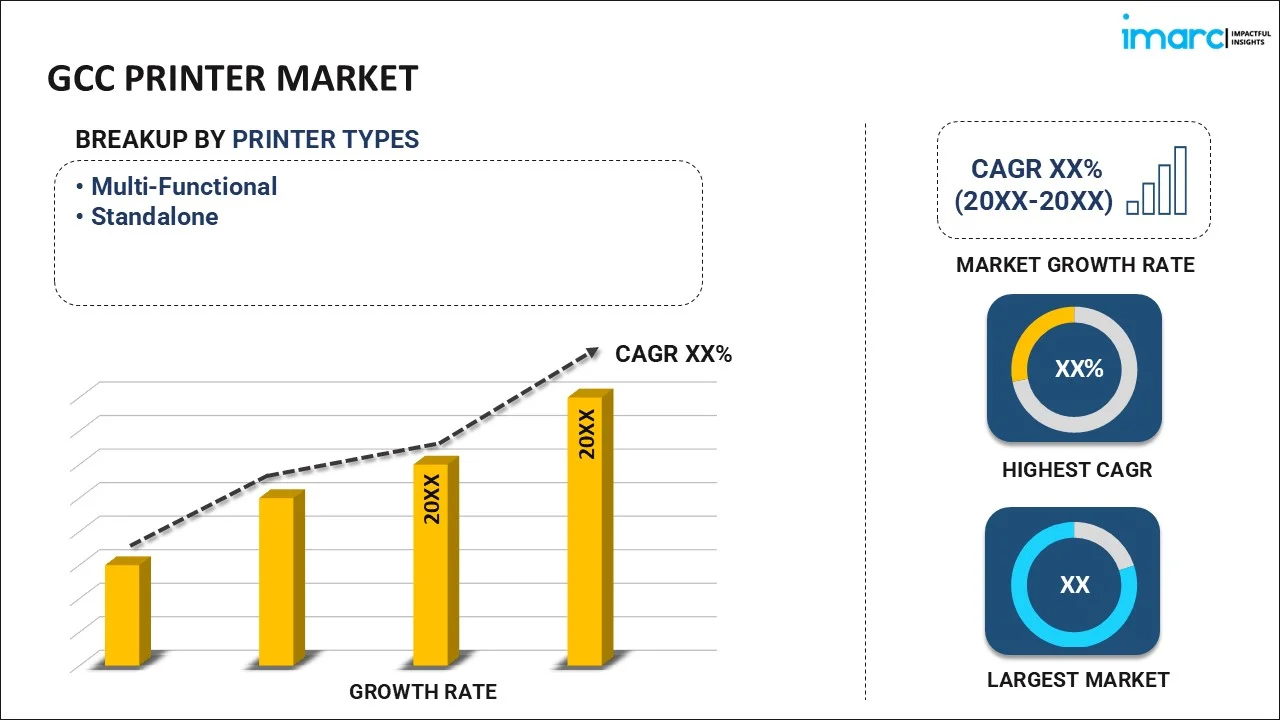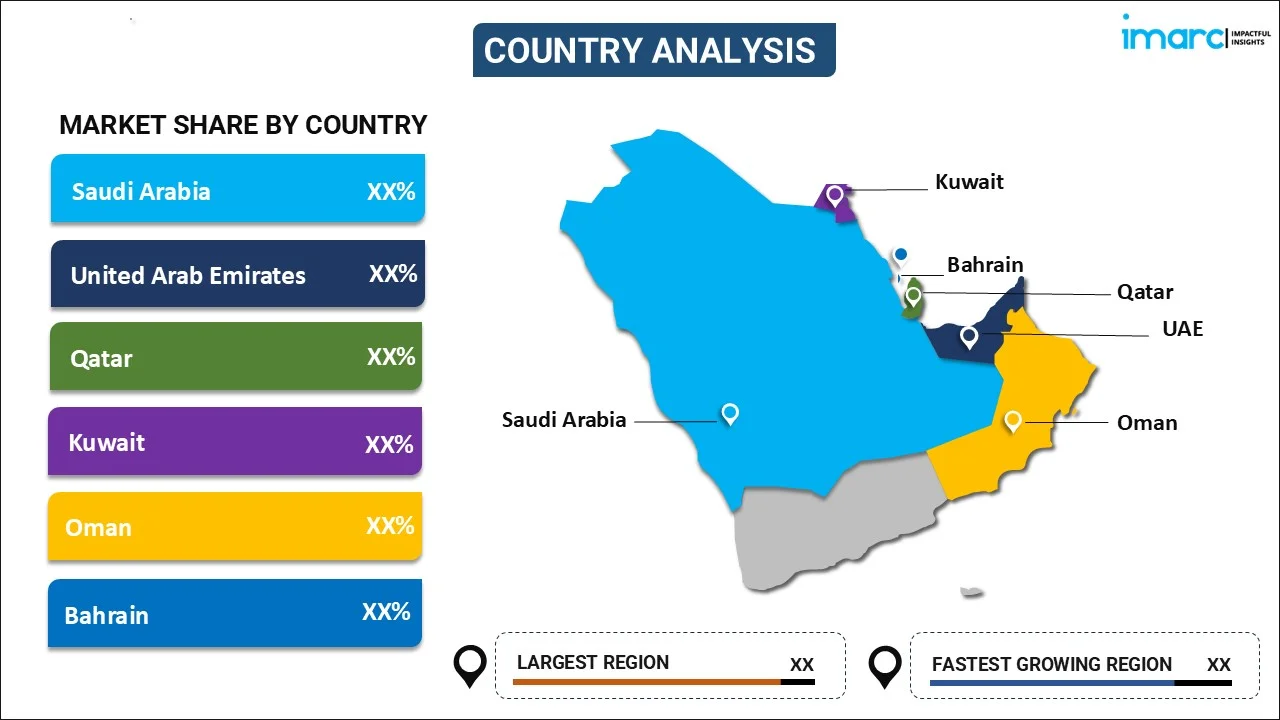
GCC Printer Market Report by Printer Type (Multi-Functional, Standalone), Technology Type (Dot Matrix Printer, Inkjet Printer, LED Printer, Thermal Printer, Laser Printer), Printer Interface (Wired, Wireless), End User (Residential, Commercial, Educational Institutions, Enterprises, Government and Others), and Country 2025-2033
Market Overview:
The GCC printer market size reached USD 2.1 Million in 2024. Looking forward, IMARC Group expects the market to reach USD 3.3 Million by 2033, exhibiting a growth rate (CAGR) of 4.5% during 2025-2033. The growing demand to print artwork, photographs, and other visual representations, widespread adoption of cloud-based technologies and mobile devices, and rising utilization in educational settings to allow students and educators to print study materials represent some of the key factors driving the market.
|
Report Attribute
|
Key Statistics
|
|---|---|
|
Base Year
|
2024 |
|
Forecast Years
|
2025-2033
|
|
Historical Years
|
2019-2024
|
| Market Size in 2024 | USD 2.1 Million |
| Market Forecast in 2033 | USD 3.3 Million |
| Market Growth Rate (2025-2033) | 4.5% |
A printer is a vital peripheral device that is used in various industries and office settings to produce hard copies of digital documents, images, photographs, and graphics on paper or other media. It works in combination with computers and other electronic devices by receiving data through wired or wireless connections and transforming it into paper. It relies on the range of printing technologies, such as inkjet, laser, thermal, and dot matrix. It is cost-effective, easy to use, convenient, reliable, and can easily print colored or black-and-white documents. It provides high-quality photo printing and general document printing quickly and efficiently. It also assists in generating receipts, labels, and tickets and allows users to create physical copies of digital documents that enable easy distribution and sharing of important information. It aids in saving time and effort by providing immediate access to hard copies of documents. Besides this, it benefits employees to quickly print materials required for meetings, presentations, or references, which enhances overall productivity in the workplace. As it can be easily connected to smartphones, tablets, laptops, and other electronic devices, the demand for printers is rising in the GCC region.
GCC Printer Market Trends:
At present, the increasing focus on reducing the expenses associated with outsourcing printing tasks in a business organization represents one of the major factors influencing the market positively in the GCC region. Moreover, the rising adoption of printers in educational settings to allow students and educators to print study materials, assignments, and lesson plans is strengthening the growth of the market in the region. Apart from this, the growing demand for modern printers that deliver high-quality prints and produce sharp text and vibrant images is offering a positive market outlook in the GCC region. Additionally, the widespread adoption of cloud-based technologies and mobile devices is offering lucrative growth opportunities to industry investors in the region. In line with this, the increasing need for printed documents as they serve as physical archives, provide a secure and tangible backup of important information, and lower the risk of data loss due to electronic failures or system crashes is impelling the market growth. Besides this, the rising adoption among artists and designers to print artwork, photographs, and other visual representations to showcase their talent and express their creativity is propelling the growth of the market in the GCC region. In addition, the increasing employment of label and barcode printers that support logistics and supply chain management is bolstering the growth of the market in the GCC region.
GCC Printer Market Segmentation:
IMARC Group provides an analysis of the key trends in each segment of the GCC printer market report, along with forecasts at the regional and country levels for 2025-2033. Our report has categorized the market based on printer type, technology type, printer interface, and end user.
Printer Type Insights:

- Multi-Functional
- Standalone
The report has provided a detailed breakup and analysis of the market based on the printer type. This includes multi-functional and standalone.
Technology Type Insights:
- Dot Matrix Printer
- Inkjet Printer
- LED Printer
- Thermal Printer
- Laser Printer
A detailed breakup and analysis of the market based on the technology type has also been provided in the report. This includes dot matrix printer, inkjet printer, LED printer, thermal printer, and laser printer.
Printer Interface Insights:
- Wired
- Wireless
A detailed breakup and analysis of the market based on the printer interface has also been provided in the report. This includes wired and wireless.
End User Insights:
- Residential
- Commercial
- Educational Institutions
- Enterprises
- Government
- Others
A detailed breakup and analysis of the market based on the end user has also been provided in the report. This includes residential, commercial, educational institutions, enterprises, government, and others.
Country Insights:

- Saudi Arabia
- UAE
- Qatar
- Bahrain
- Kuwait
- Oman
The report has also provided a comprehensive analysis of all the major regional markets, which include Saudi Arabia, the UAE, Qatar, Bahrain, Kuwait, and Oman.
Competitive Landscape:
The report has also provided a comprehensive analysis of the competitive landscape in the market. Competitive analysis such as market structure, key player positioning, top winning strategies, competitive dashboard, and company evaluation quadrant has been covered in the report. Also, detailed profiles of all major companies have been provided.
GCC Printer Market Report Coverage:
| Report Features | Details |
|---|---|
| Base Year of the Analysis | 2024 |
| Historical Period | 2019-2024 |
| Forecast Period | 2025-2033 |
| Units | Million USD |
| Scope of the Report | Exploration of Historical and Forecast Trends, Industry Catalysts and Challenges, Segment-Wise Historical and Predictive Market Assessment:
|
| Printer Types Covered | Multi-Functional, Standalone |
| Technology Types Covered | Dot Matrix Printer, Inkjet Printer, LED Printer, Thermal Printer, Laser Printer |
| Printer Interfaces Covered | Wired, Wireless |
| End Users Covered | Residential, Commercial, Educational Institutions, Enterprises, Government, Others |
| Countries Covered | Saudi Arabia, UAE, Qatar, Bahrain, Kuwait, Oman |
| Customization Scope | 10% Free Customization |
| Post-Sale Analyst Support | 10-12 Weeks |
| Delivery Format | PDF and Excel through Email (We can also provide the editable version of the report in PPT/Word format on special request) |
Key Questions Answered in This Report:
- How has the GCC printer market performed so far and how will it perform in the coming years?
- What has been the impact of COVID-19 on the GCC printer market?
- What is the breakup of the GCC printer market on the basis of printer type?
- What is the breakup of the GCC printer market on the basis of technology type?
- What is the breakup of the GCC printer market on the basis of printer interface?
- What is the breakup of the GCC printer market on the basis of end user?
- What are the various stages in the value chain of the GCC printer market?
- What are the key driving factors and challenges in the GCC printer market?
- What is the structure of the GCC printer market and who are the key players?
- What is the degree of competition in the GCC printer market?
Key Benefits for Stakeholders:
- IMARC’s report offers a comprehensive quantitative analysis of various market segments, historical and current market trends, market forecasts, and dynamics of the GCC printer market from 2019-2033.
- The research study provides the latest information on the market drivers, challenges, and opportunities in the GCC printer market.
- Porter's five forces analysis assist stakeholders in assessing the impact of new entrants, competitive rivalry, supplier power, buyer power, and the threat of substitution. It helps stakeholders to analyze the level of competition within the GCC printer industry and its attractiveness.
- Competitive landscape allows stakeholders to understand their competitive environment and provides an insight into the current positions of key players in the market.
Need more help?
- Speak to our experienced analysts for insights on the current market scenarios.
- Include additional segments and countries to customize the report as per your requirement.
- Gain an unparalleled competitive advantage in your domain by understanding how to utilize the report and positively impacting your operations and revenue.
- For further assistance, please connect with our analysts.
 Inquire Before Buying
Inquire Before Buying
 Speak to an Analyst
Speak to an Analyst
 Request Brochure
Request Brochure
 Request Customization
Request Customization




.webp)




.webp)












